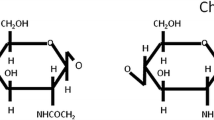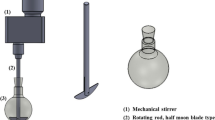Abstract
We have developed a technique for the immobilization of inulinase on chitosans with different molecular weights. The acid-soluble mid-molecular-weight (200 kDa) and high-molecular-weight (350 kDa) chitosans are shown to be promising matrices for inulinase adsorption. We assumed that the formation of an inulinase-chitosan matrix complex occurs mainly due to hydrophobic interactions; electrostatic interactions also play an essential role. The enzyme complex with high-molecular-weight chitosan is more stable against the action of UV light and temperature. This allows us to recommend chitosan as a catalyst in industry for the production of fructose from inulin-containing vegetable raw mateials.
Similar content being viewed by others
References
V. A. Abelyan and L. S. Manukyan, Biochemistry (Moscow) 61 (6), 1028 (1996).
N. A. Zherebtsov, O. S. Korneeva, and T. N. Tertychnaya, Appl. Biochem. Microbiol. 35 (2), 107 (1999).
O. S. Korneeva, Carbohydrases: Preparative Isolation, Structure, and Mechanism of Action on Oligo-and Polysaccharides (Voronezh State Univ., Voronezh, 2001) [in Russian].
G. G. Sokolenko and N. A. Karpechenko, Microbiology 84 (1), 23 (2015).
K. G. Skryabin, Chitin and Chitosan: Preparation, Properties, and Applications (Nauka, Moscow, 2002) [in Russian].
O. O. Loginova, M. G. Holyavka, and V. G. Artyukhov, Biofarmatsevt. Zh. 2, 13 (2015).
D. A. Slivkin, V. L. Lapenko, O. A. Safonova, et al., Vestn. Voronezh. Gos. Univ. 2, 214 (2011).
M. G. Holyavka, T. A. Kovaleva, M. V. Grechkina, et al., Appl. Biochem. Microbiol. 50 (1), 10 (2014).
O. H. Lowry, N. J. Rosebrough, A. L. Faar, and R. J. Randall, J. Biol. Chem. 193, 265 (1951).
T. A. Kovaleva, M. G. Kholyavka, A. S. Takha, Biotechnology in Russia, No. 3, 106 (2007).
F. C. MacLaughlin, R. J. Mumper, J. Wang, et al., J. Controlled Release 56, 259 (1998).
M. Arand, A. M. Golubev, J. R. Neto, et al., Biochem. J. 362, 131 (2002).
T. A. Kovaleva, M. G. Kholyavka, and V. G. Artyukhov, Biotechnology in Russia, No. 1, 43 (2012).
A. Pessoa and M. Vitolo, Biotechnol. Techn. 11, 421 (1997).
R. Xiao, M. Tanida, and S. Takao, J. Ferment. Technol. 67, 331 (1989).
Y. Ji and X. Zhao, Wei Sheng Wu Xue Bao 38, 120 (1998).
M. Warchol, S. Perrin, J. P. Grill, and F. Schneider, Lett. Appl. Microbiol. 35, 462 (2002).
M. G. Holyavka, T. A. Kovaleva, S. I. Karpov, et al., Biophysics 59 (2), 222 (2014).
T. A. Kovaleva and M. G. Holyavka, Vopr. Biol. Med. Farm. Khim. 1, 3 (2011).
Author information
Authors and Affiliations
Corresponding author
Additional information
Original Russian Text © M.G. Holyavka, V.G. Artyukhov, P.V. Seredin, 2016, published in Biofizika, 2016, Vol. 61, No. 6, pp. 1109–1117.
Rights and permissions
About this article
Cite this article
Holyavka, M.G., Artyukhov, V.G. & Seredin, P.V. The interaction of inulinase molecules with a chitosan matrix: UV-induced changes in the functional properties of immobilized inulinase. BIOPHYSICS 61, 871–876 (2016). https://doi.org/10.1134/S0006350916060099
Received:
Published:
Issue Date:
DOI: https://doi.org/10.1134/S0006350916060099




